Nissan Rogue Owners Manual: Rear-facing child restraint installation using the seat belts
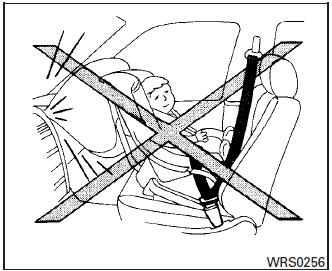
Rear-facing child restraint installation using the seat belts
| WARNING The three-point seat belt with Automatic Locking Retractor (ALR) must be used when installing a child restraint. Failure to use the ALR mode will result in the child restraint not being properly secured. The restraint could tip over or be loose and cause injury to a child in a sudden stop or collision. Also, it can change the operation of the front passenger air bag. For additional information, refer to ŌĆ£Supplemental air bag warning lightŌĆØ in this section. |
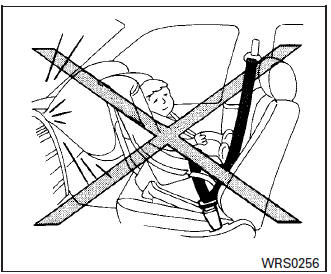
Rear-facing ŌĆō step 1
For additional information, refer to all Warnings and Cautions in the ŌĆ£Child safetyŌĆØ and ŌĆ£Child restraintsŌĆØ sections before installing a child restraint.
NISSAN does not recommend the use of the lower anchors if the combined weight of the child and the child restraint exceeds 65 lbs (29.5 kg). If the combined weight of the child and the child restraint is greater than 65 lbs (29.5 kg), use the vehicleŌĆÖs seat belt (not the lower anchors) to install the child restraint. Be sure to follow the child restraint manufacturerŌĆÖs instructions for installation.
Follow these steps to install a rear-facing child restraint using the vehicle seat belts in the rear seats:
- Child restraints for infants must be
used in the rear-facing direction and
therefore must not be used in the front
seat. Position the child restraint on the seat.
Always follow the restraint manufacturerŌĆÖs instructions.
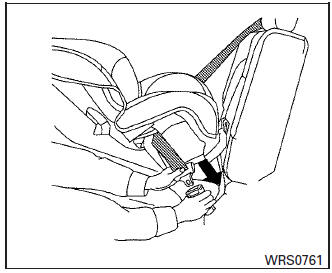
Rear-facing ŌĆō step 2
- Route the seat belt tongue through the child restraint and insert it into the buckle until you hear and feel the latch engage. Be sure to follow the child restraint manufacturerŌĆÖs instructions for belt routing.
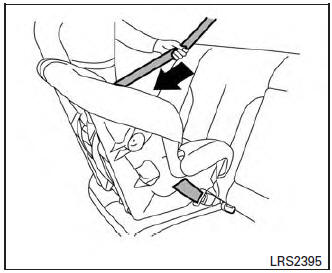
Rear-facing ŌĆō step 3
- Pull the shoulder belt until the belt is fully extended. At this time, the seat belt retractor is in the ALR mode (child restraint mode). It reverts to the ELR mode when the seat belt is fully retracted.
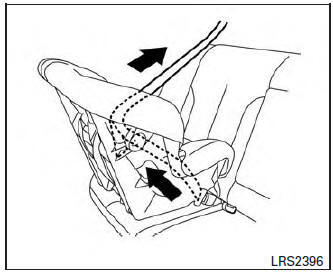
Rear-facing ŌĆō step 4
- Allow the seat belt to retract. Pull up on the shoulder belt to remove any slack in the belt.
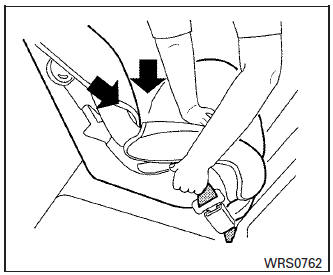
Rear-facing ŌĆō step 5
- Remove any additional slack from the seat belt; press downward and rearward firmly in the center of the child restraint to compress the vehicle seat cushion and seatback while pulling up on the seat belt.
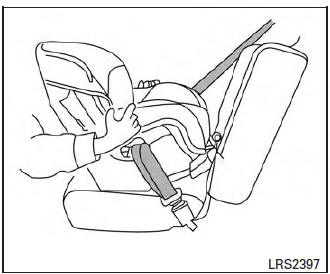
Rear-facing ŌĆō step 6
- After attaching the child restraint, test it before
you place the child in it. Push it from side
to side while holding the child restraint near
the seat belt path. The child restraint should
not move more than 1 inch (25 mm), from
side to side. Try to tug it forward and check
to see if the belt holds the restraint in place.
If the restraint is not secure, tighten the seat belt as necessary, or put the restraint in another seat and test it again. You may need to try a different child restraint. Not all child restraints fit in all types of vehicles.
- Check to make sure that the child restraint is properly secured prior to each use. If the seat belt is not locked, repeat steps 1 through 6.
After the child restraint is removed and the seat belt fully retracted, the ALR mode (child restraint mode) is canceled.
 Rear-facing child restraint installation using
LATCH
Rear-facing child restraint installation using
LATCH
For additional information, refer to all Warnings
and Cautions in the ŌĆ£Child SafetyŌĆØ and ŌĆ£Child
RestraintŌĆØ sections before installing a child restraint.
NISSAN does not recommend the use ...
 Forward-facing child restraint installation
using LATCH
Forward-facing child restraint installation
using LATCH
For additional information, refer to all Warnings
and Cautions in the ŌĆ£Child SafetyŌĆØ and ŌĆ£Child
RestraintsŌĆØ sections before installing a child restraint.
NISSAN does not recommend the use ...
Other materials:
Inside mirror
Wiring Diagram - With Homelink Universal Transceiver
Wiring Diagram - Without Homelink Universal Transceiver
...
DTC/circuit diagnosis
B2600-46 CONFIG ERROR
DTC Description
DTC DETECTION LOGIC
DTC
Trouble diagnosis
(Trouble diagnosis contents)
Detecting condition
B2600-46
CONFIG ERROR
(Configuration error)
When errors are detected in the configuration data stored in the BCM
(CAN
...
The steering switches are inoperative
Description
One or more of the steering switches to control the information display are
inoperative.
Diagnosis Procedure
1.CHECK STEERING SWITCH CIRCUIT
Check steering switch circuit. Refer to MWI-69, "Diagnosis Procedure".
Is the inspection result normal?
YES >> GO TO 2.
...
